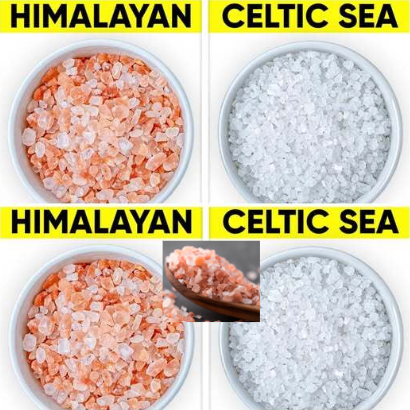
Let’s be honest — salt isn’t the most glamorous ingredient in your pantry, but it is one of the most important. And if you’ve ever stood in the grocery aisle torn between that rosy Himalayan salt and the grayish Celtic sea salt, you’re not alone. Both are natural, mineral-rich alternatives to heavily processed table salt. But which one really packs more flavor, nutrition, and versatility?
Well, it’s time to put them head-to-head and see which salt actually deserves your kitchen spotlight.
What Makes Himalayan Pink Salt So Special?
You’ve seen those gorgeous pink crystals sitting in grinders or glowing inside fancy salt lamps. But Himalayan salt isn’t just pretty — it’s got some impressive roots.
- Origin: It comes from ancient sea beds tucked deep in the Himalayan mountains of Pakistan.
- Color & Taste: The pink tint? That’s thanks to iron oxide and dozens of trace minerals. It has a mild, earthy taste — never too sharp or overpowering.
- Mineral Content: Over 80 trace minerals, including magnesium, calcium, and potassium, make it more than just sodium chloride in disguise.
- Common Uses: Ideal for cooking, seasoning, and even skincare. A relaxing bath soak? Himalayan salt’s got your back.
- Texture: Usually found in coarse grains but also comes finely ground. It’s perfect as a finishing salt that adds both flavor and flair.
The Salty Scoop on Celtic Sea Salt
On the flip side, we’ve got Celtic sea salt — often overlooked but beloved by traditionalists and health enthusiasts alike.
- Origin: Harvested using age-old methods from tidal pools along the French Atlantic coast, especially in Brittany.
- Color & Taste: Soft gray, moist crystals with a bold, briny, ocean-like flavor.
- Mineral Richness: High in magnesium and packed with other trace minerals, especially because of its moisture content — the water helps lock those minerals in.
- Everyday Uses: Amazing for seasoning grilled meats, seafood, and hearty stews. Also popular for mixing into mineral-rich drinks.
- Texture: Damp, slightly clumpy, and dissolves quickly into food — a favorite of chefs who love its rustic feel.
Video : Himalayan vs. Celtic Sea Salt: WHICH IS BETTER?
Key Differences You Should Know
Okay, let’s lay it out — side by side.
| Feature | Himalayan Pink Salt | Celtic Sea Salt |
|---|---|---|
| Flavor | Mild, earthy | Bold, briny |
| Color | Pink hues | Light gray |
| Texture | Dry, crunchy | Moist, clumpy |
| Minerals | 80+ trace minerals | High in magnesium & iron |
| Origin | Mined from ancient sea beds | Harvested from French tidal pools |
| Processing | Minimal | Minimal |
So, is one clearly better? Not really. They’re just different — and that’s where it gets fun.
When to Use Himalayan Salt
This salt works wonders when you want subtle flavor and visual appeal. Think:
- Grilled veggies
- Light salad dressings
- Roasted nuts
- Salt crust baking (fish or meat)
- Sprinkled on dark chocolate or caramel desserts
It’s also great for bath soaks, body scrubs, and, yes, decorative salt lamps if you’re into that wellness vibe.
When to Use Celtic Sea Salt
Go Celtic when you’re craving something more robust and savory. It’s your go-to for:
- Hearty soups and stews
- Marinades and brines
- Red meats or fatty fish
- Electrolyte water (a pinch in your glass)
- Any dish where salt is a hero, not just a background note
Its naturally moist texture helps it dissolve faster, so it blends beautifully in cooking.
Which One’s Healthier?
Here’s the truth: Neither salt is a magic health bullet, but both are miles ahead of processed table salt.
- Himalayan: Slightly lower in sodium per gram, making it gentler if you’re watching your intake.
- Celtic: May have a slight edge in magnesium, which is great for muscle and nerve function.
- Both contain zero additives and retain their natural mineral profile, unlike table salt which often gets stripped down and mixed with anti-caking agents or iodine.
If you’re looking for salt that nourishes as it seasons, either one is a smart move.
Cost and Convenience: What to Expect
Let’s talk practicality. You might find Himalayan salt a bit easier to source — it’s everywhere, from supermarkets to big-box stores. Celtic salt is slightly less common and sometimes comes with a higher price tag, especially the hand-harvested stuff.
Still, a little goes a long way, and one bag or jar can last you months. So don’t let price be the only factor — go with what suits your cooking style and taste buds.
Video : CELTIC SEA SALT vs HIMALAYAN PINK SALT Minerals Comparison + More Differences
Final Thoughts: Why You Don’t Have to Choose Just One
Here’s the fun part — you don’t have to pick a side.
Think of it like choosing spices. You wouldn’t use cinnamon in every dish, right? Salt’s the same. Each variety brings its own personality to the table, and you can use both to elevate your meals and your health.
Himalayan pink salt? Smooth, subtle, and perfect when you want to keep things light and clean. Celtic sea salt? Deep, intense, and just right for when you want your food to sing with flavor.
So, go ahead — stock both in your kitchen arsenal. With these natural salts on hand, you’ll be seasoning like a pro and savoring every pinch.


